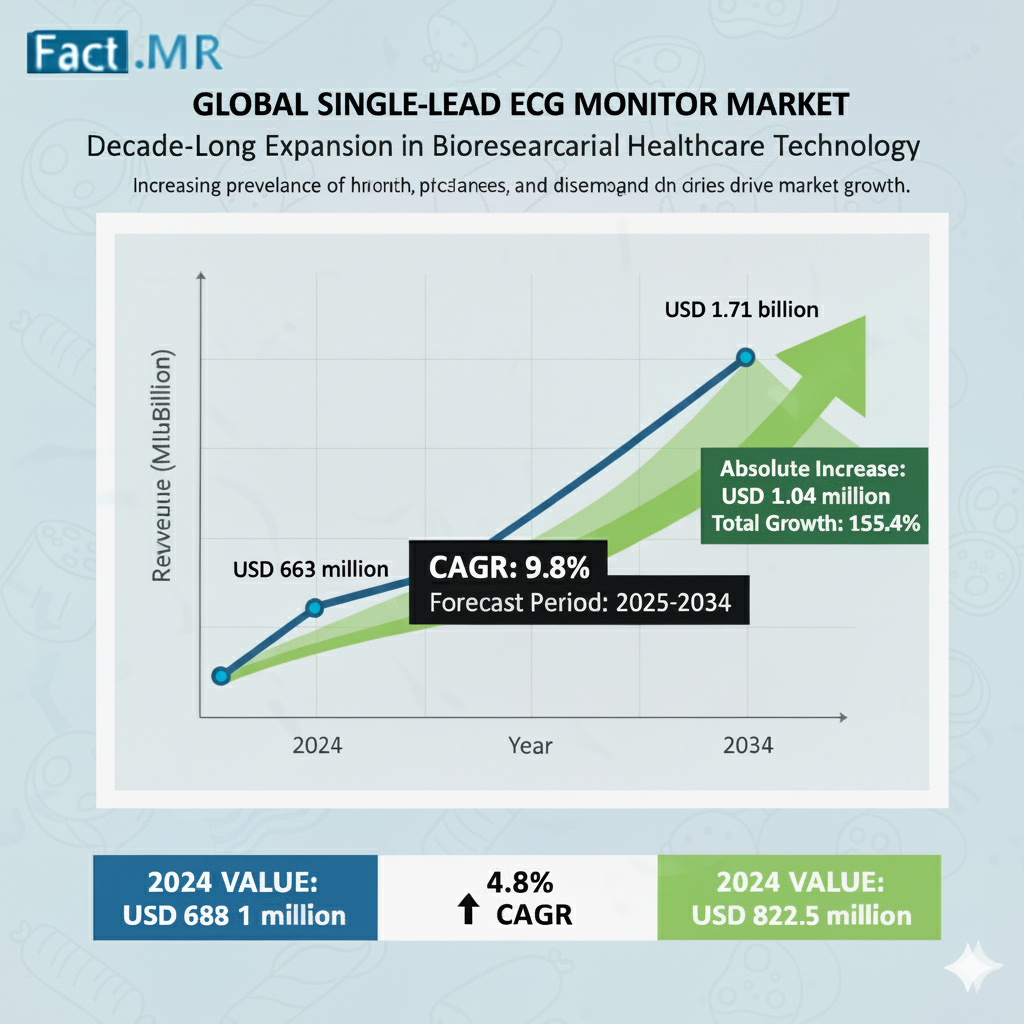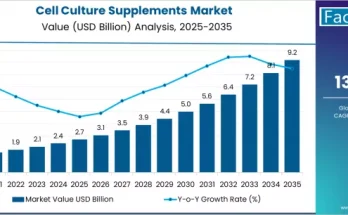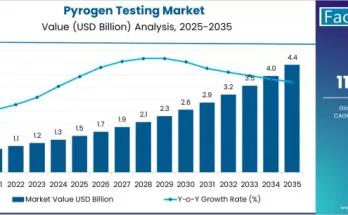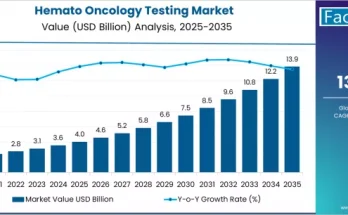Revenue from the global single-lead ECG monitor market is evaluated to increase from US$ 669 million in 2024 to US$ 1.71 billion by the end of 2034. The market has been analyzed to increase at 9.8% CAGR from 2024 to 2034. Increasing prevalence of heart-related disorders is giving rise to the high demand for single-lead ECG monitors across the world.This growth trajectory is fueled by the escalating prevalence of cardiovascular disorders worldwide, driven by shifting lifestyles, dietary habits, and an aging population. Single-lead electrocardiogram (ECG) monitors, which capture the heart’s electrical activity via electrodes placed primarily on the chest (and occasionally limbs), offer a non-invasive, painless, and rapid diagnostic tool. These devices empower healthcare providers to assess cardiac conditions accurately, facilitating timely interventions and surgeries. As heart-related ailments surge—particularly among the elderly who are more vulnerable and less tolerant of invasive procedures—the demand for portable, user-friendly single-lead ECGs has skyrocketed, expanding market opportunities across diverse demographics.
Key Drivers of Market Growth:
Several pivotal factors underpin this upward trend. Electrocardiography outperforms alternatives like photoplethysmography in precision, delivering reliable heart rate data essential for surgical planning and ongoing monitoring. Government healthcare investments are accelerating adoption by funding advanced technologies that enhance patient outcomes. Modern single-lead ECGs incorporate automated algorithms, interpreting cardiac rhythms in real-time and allowing physicians to prioritize complex cases, thereby optimizing workflows and reducing consultation times.
These monitors are versatile, safe for all ages and genders, with no adverse effects, making them indispensable in operating theaters for intraoperative heart surveillance. The advent of portable and wireless variants has revolutionized accessibility; patients can now self-monitor at home or on-the-go, supporting telehealth and sports applications. Wireless models eliminate cumbersome cables, enabling seamless telemonitoring and athletic performance tracking. Manufacturers are investing heavily in R&D to create affordable, reliable, and compact solutions, broadening accessibility and propelling global market penetration. Innovations in healthcare tech, including integration with digital platforms, further amplify growth.
Importance in Heart Health Assessment:
Single-lead ECG monitors are critical for early detection amid rising lifestyle-induced disorders. Heart disease and stroke dominate global mortality, exacerbated by unhealthy diets, sedentary habits, smoking, alcohol abuse, and substance use. Risk factors like hypertension, elevated glucose, obesity, and dyslipidemia are readily identifiable in primary care settings using these devices, prompting widespread adoption.
The shift toward home-based cardiac care and sports monitoring is another boon. Portable ECGs enable self-triaging during exercise, arrhythmia detection, syncope evaluation, and cardiovascular risk assessment. For high-risk groups—those with diabetes, hypertension, hypercholesterolemia, or obesity—devices like Omron Corporation’s HeartScan provide proactive insights. Increased R&D has yielded advanced portables capable of flagging potential issues, fostering preventive strategies and market expansion.
Challenges and Physician Hesitancy:
Despite promising prospects, challenges persist. Single-lead ECGs capture only momentary snapshots, potentially missing intermittent irregularities. This risk of undetected anomalies raises patient safety concerns, leading to diagnostic discrepancies, compromised care, or even fatalities. Many physicians hesitate to depend solely on these devices, preferring multi-lead systems for comprehensive views, which dampens sales. Manufacturers are countering this by enhancing detection algorithms and promoting complementary use, aiming to rebuild trust and dominate the market.
Regional Insights:
North America commands 41.5% of the market in 2024, with the U.S. valued at US$223.9 million and projected to reach US$579.4 million by 2034 at a 10% CAGR. Post-COVID telemedicine integration and real-time remote monitoring are key drivers, enabling prompt interventions and attracting suppliers.
Canada’s market advances at 9.9% CAGR, claiming 13.5% of North America’s share by 2034. In Latin America, the segment grows to 5.7% by 2034, with Brazil’s market expanding from US$16.4 million in 2024 to US$44.1 million at 10.4% CAGR. Brazil benefits from rising cardiovascular incidence, geriatric demographics, infrastructure upgrades, preventive awareness, and medical tourism lured by cost-effective treatments. Government policies and collaborations with hospitals bolster demand for sophisticated ECGs. Sales also surge in Mexico and Chile, reflecting regional health priorities.
Category-Wise Breakdown:
Segmentation reveals nuanced preferences. By application, conduction disorders diagnosis leads with 32.5% share in 2024, growing at 9.7% CAGR. Other applications include atrial fibrillation, bradycardia, and tachycardia.
Recording-based single-lead ECGs dominate product types, valued at US$529.1 million in 2024 and forecasted to hit US$1.36 billion by 2034 at 9.9% CAGR. Unlike traditional ECGs lacking data storage, these allow historical comparisons, aiding longitudinal analysis.
Hospitals drive end-user sales, with US$347.6 million in 2024 rising to US$886.7 million at 9.9% CAGR, owing to skilled surgical teams requiring constant monitoring for pre-operative and intraoperative assessments. Home care and other settings follow.
Competitive Landscape and Key Players:
Competition intensifies as firms launch innovations and pursue strategic alliances. Mergers, acquisitions, partnerships, and adaptations to trends like ECG telemetry and lead wires are common. In September 2023, iRhythm Technologies unveiled the next-generation Zio® monitor—its smallest, lightest model—with enhanced long-term continuous monitoring services, improving patient and provider experiences.
Prominent companies include Dimetek Digital Medical Technologies Ltd., AliveCor Inc., Tianjin Chase Sun Pharmaceutical Group, Ambisea Technology Corp., Zenicor Medical Systems, OMRON Corporation, and Perlong Medical Equipment Co. Fact.MR’s report details pricing, sales growth, capacities, and technological speculations.
Market Segmentation Summary:
- Product Type: Recording-Based; Real-Time Single-Lead ECG Monitors.
- Application: Atrial Fibrillation; Bradycardia; Conduction Disorders; Tachycardia.
- End User: Hospital Facilities; Home Care Settings; Others.
- Region: North America; Latin America; Eastern Europe; Western Europe; East Asia; South Asia & Pacific; Middle East & Africa.
In summary, the single-lead ECG monitor market’s evolution reflects broader healthcare shifts toward precision, portability, and prevention. Overcoming limitations through innovation will sustain its 9.8% CAGR, transforming cardiac care globally.
Browse Full Report-https://www.factmr.com/report/single-lead-ecg-monitor-market



